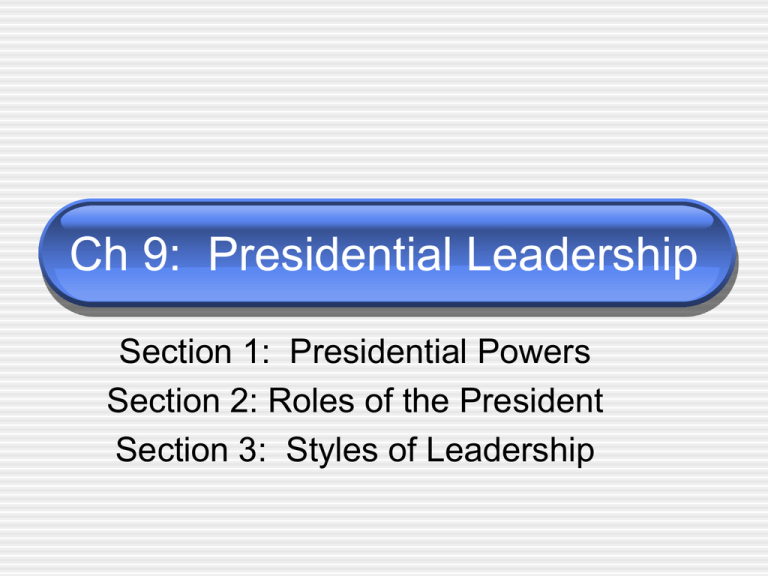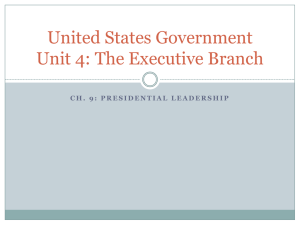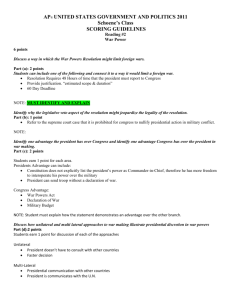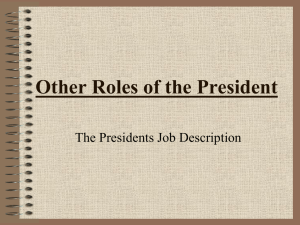Ch 9: Presidential Leadership
advertisement

Ch 9: Presidential Leadership Section 1: Presidential Powers Section 2: Roles of the President Section 3: Styles of Leadership Section 1: Presidential Powers • I. Constitutional Powers • A. The founders created a strong executive to • • overcome the weaknesses of the Articles of Confederation. B. Most of the powers we think of the president having today have evolved over time, reflecting the changing needs of the nation, and the personalities of those in the executive office. Mandates from the people have also shaped the presidency (FDR during the New Deal, for instance) • C. Article II grants the president broad but vaguely described powers: Head of the executive branch Commander in chief Conducts foreign policy Has judicial powers Presidential Powers continued • II. Informal Sources of Power • A. Personal Exercise of Power Certain presidents have expanded the power of the executive to fit needs as they saw them. Consider some historical examples: • Jefferson’s decision to buy the Louisiana Territory • T. Roosevelt’s claim that it was the right and duty of the president to “do anything that the needs of the Nation demanded unless such action was forbidden by the Constitution or by the law.” • Consider the current debate over the Bush administration’s creation of the NSA warrant-less surveillance program. • C. Modern presidents usually refer to a mandate from the people when attempting to expand the role of the president and use the mass media to build support for their ideas. These media outlets provide a forum for the president to spread the administration’s message. • Discussion question: Do you think modern presidents have tried to gain powers the authors of the Constitution did not intend for them to have? (outside the scope of original intent?) III: Limits on Presidential Power • A. Congress has constitutional authority to override a presidential veto. Ex. Nixon’s veto of the War Powers Act • B. The president can be impeached and • removed from office for clear abuse of power C. The Supreme Court can overturn presidential actions Ex. President Truman in Youngstown v. Sawyer (1952) III: Limits continued • D. Congress has the “power of the purse”, so it • • • has final control over the budget. How does this act as a check on presidential power? E. The Senate must approve presidential appointments. F. Limitation by the bureaucracy--who actually enforces the laws? G. Limitation by public opinion--remember the idea of a mandate? Johnson’s decision not to run again because of Vietnam Clinton and health care Section 2: Roles of the President • Some of what we expect the president to do is in Article II and some of it has developed over time and become custom. • A. Head of State In this role, the president represents the nation at ceremonial functions Serves as a symbol of the whole country II. Roles of the President continued • B. Chief Executive In charge of the executive branch and its 2 million+ employees Can issue executive orders, which have the same effect as a law Makes appointments (2,200 federal jobs) Appoints justices to the Supreme Court Removes appointed officials Has the power of impoundment (Nixon) Can issue reprieves and pardons Can grant amnesty II. Roles of the President continued • III. Chief Legislator • A. The president often proposes legislation to Congress. The State of the Union address is usually an outline of the presidential agenda for the year. • B. Although he can propose legislation, Congress must still pass the bill. The president faces more opposition when the opposing party is in control of Congress. He may use political favors to gain support for legislation he really wants to see pass. (campaign support, etc) Can use the threat of veto to persuade Congress to cooperate. II. Roles continued • IV. Chief Economist The president also acts as the country’s top economic planner, although congress created the Council of Economic Advisors in 1946 to assist. A. Since the New Deal, the president’s use of this role has in increased. B. Economic goals the president pursues include high employment, production and purchasing power. C. One way the president directly influences the economy is by developing the country’s budget every year. II. Roles continued • V. Party Chief • The president acts as head of his political party. As • • • party leader, the president: A. Helps raise campaign funds B. Helps organize and plan party strategy for campaigns and policy issues C. Uses political patronage to appoint party member to government jobs. • Discussion question: Can this role ever be in conflict with other duties the president has? II. Roles continued • VI. Chief diplomat • As chief diplomat, the president. . . • A. Directs foreign policy and oversees foreign affairs • information agencies such as the CIA, the State department and the National Security Council. B. Has sole power to make treaties, which are subject to Senate approval. (Remember WWI and the Treaty of Versailles?) • C. May make executive agreements with foreign nations. Ex. FDR’s “lend/lease” program to aid the British in WWII. • Has the sole power to recognize foreign governments. II. And finally. . . • • • • • • • VII. Commander-in-Chief As commander in chief, the president: A. Shares with Congress the power to go to war B. Makes key military decisions. C. Supports war efforts on the home front during times of war. D. May use the armed forces to handle domestic issues such as natural disasters. Remember that use of the military is a power that Congress watches very closely. Historically, this has led to tensions between the executive and legislative branches. III. Styles of Leadership • All presidents have the same tools of leadership • • available to them, but since they are individuals, they choose to use them in different ways. A. The Founders originally expected that the legislative branch would be the “dominant” branch and would lead the nation, not the president. B. One way presidents provide leadership is in introducing new ideas as well as responding to crises at home and abroad. Truman and civil rights Nixon and China Bush (43) after 9/11 II. Leadership Qualities and Skills • Could you be president? Do you have the following? • A. Presidents must have a good sense of what’s • • • important to Americans and understand what the people want (mandates again) B. Presidents must be good communicators (chief persuader) C. Presidents must have a keen sense of timing D. Successful presidents: Are flexible and open to new ideas Are able to compromise But be willing to go against public opinion in matters they think are important. III. Presidential Isolation • One increased danger presidents face today is that their dependence on White House staff and close advisors will isolate them. Special treatment of a president by staff and advisers risks keeping information from them that helps them carry out their duties. Problems of personality--presidents may discourage staffers from disagreeing with them or giving them advice they don’t want to hear. Access to the president is controlled by top aides Dealing with staff issues cuts down on the time the president has to stay in touch with the people. Examples: Nixon and Regan IV: Executive Privilege • Because much of the advice presidents get and • • discussions they have involve classified information, presidents aren’t always comfortable letting Congress, the public or the media know what’s going on. They often rely on “executive privilege” to protect this information. Modern presidents have also claimed that executive privilege includes their communications with other members of the executive branch. The Supreme court has ruled that executive privilege is constitutionally based, but not without limits. U.S. v. Nixon http://www.oyez.org/oyez/resource/case/410/ The Pentagon Papers (Johnson & Vietnam)








